Free Online Productivity Tools
i2Speak
i2Symbol
i2OCR
iTex2Img
iWeb2Print
iWeb2Shot
i2Type
iPdf2Split
iPdf2Merge
i2Bopomofo
i2Arabic
i2Style
i2Image
i2PDF
iLatex2Rtf
Sci2ools
COMPSEC
2010
2010
Taming role mining complexity in RBAC
In this paper we address the problem of reducing the role mining complexity in RBAC systems. To this aim, we propose a three steps methodology: first, we associate a weight to roles; second, we identify user-permission assignments that cannot belong to roles with a weight exceeding a given threshold; and third, we restrict the role-finding problem to user-permission assignments identified in the second step. We formally show--the proofs of our results are rooted in graph theory--that this methodology allows role engineers for the elicitation of stable candidate roles, by contextually simplifying the role selection task. Efficient algorithms to implement our strategy are also described. Further, we discuss practical applications of our approach. Finally, we tested our methodology on real data set. Results achieved confirm both the viability of our proposal and the analytical findings. Key words: Role-Based Access Control, Stable Roles, Clustering Coefficient, Administration Cost Minimi...
| Added | 01 Feb 2011 |
| Updated | 01 Feb 2011 |
| Type | Journal |
| Year | 2010 |
| Where | COMPSEC |
| Authors | Alessandro Colantonio, Roberto Di Pietro, Alberto Ocello, Nino Vincenzo Verde |
Comments (0)

